Editor’s note: This is the final installment of the two-part “Taking Measure” series, which examines Watsonville’s Measure G and its sunset in 2021. The previous installment was published in the Feb. 15-21 edition of the Pajaronian. Click here to read the first installment.
WATSONVILLE — In a mostly empty City Council Chambers on Feb. 13, the Revenue Measure Oversight Committee received an update on Watsonville’s Measure G in its first of two meetings of the year.
The committee is tasked with providing oversight for the 2014 voter-approved measure, which enacted a half-cent sales tax in the city, with revenue headed to the police and fire departments.
Ten members of the 11-person committee were present for the meeting, consisting of business owners, realtors, police and fire representatives and others.
The committee took on nearly an entirely new look during the meeting, with six new members being welcomed. With committee members only able to serve a pair of two-year terms, most of the original members from 2014 have termed out.
With the new-look committee in place, led by chair Rick Danna, they will be faced with guiding the measure during one of the most critical times in its seven-year lifespan. With Measure G sunsetting in 2021 and an uncertain economic landscape in the near future, city officials are hoping voters will once again jump on board if the measure is placed on a future ballot for renewal.
•••
Filling the gap
When Measure G came to fruition, the hope was among city leaders that the sales tax would be a stopgap to help Watsonville weather the economic recession without compromising public safety.
The hope was, also, that the city would be in a better financial position by 2021 and would be able to absorb the new hires brought on by the sales tax’s revenues.
But with 2021 only two years away, a reality is starting to sink in: While the city is better off financially now than it was in 2013, its general fund still can not fully support the spending, according to City Manager Matt Huffaker. Fears that another nationwide recession is imminent further compound matters.
Perhaps the biggest issue of all is something that Watsonville is not alone in facing.
The California Public Employees’ Retirement System (CalPERS), which manages the city’s pensions, is faced with an imbalance in its fund, paying out more in benefits than it is collecting from workers’ contributions.
As a result, the agency announced in late 2016 that it would lower its discount rate from 7.5 percent to 7 percent over a period of three years, which means government agencies and other organizations that contract with CalPERS must pay more into the fund to address the imbalance.
For Watsonville, that is projected to cost the city about $1 million each year for the next three years, according to a budget report by Administrative Services Director Cindy Czerwin in May 2018, putting the general fund in a deficit by 2020.
New funding sources coming in to the city show some promise.
In November, voters passed Measure O, which raised the city’s transient occupancy tax to 12 percent. Known as TOT, the tax is charged to travelers when they stay in a hotel for 30 days or less. Among the city’s eight hotels, it is expected to generate about $130,000 annually for the general fund.
That number is expected to increase slightly once two more hotels are up and running on the corner of Lee Road and West Beach Street. One of the hotels is currently under construction.
Cannabis taxes have the potential to be a boon for the city, although it hasn’t yet lived up to its expectation.
When voters passed Measure L in 2016, the tax on cannabis businesses in the city was expected to net more than $800,000 annually. But with electrical delays and other issues, the city’s six permitted facilities have been slow to open, and Watsonville expects to net $350,000 in 2019, according to Huffaker.
Watsonville’s cannabis ordinance allows only cultivation, manufacturing and distribution of marijuana for both medical and recreational uses. Dispensaries are expected to be considered later this year.
“It’s been incrementally growing,” Huffaker said. “But the cannabis industry is still a very young industry. As the cannabis operations mature and the dust settles, we will start to see those numbers rise.”
Besides cannabis, new retail developments in the works, such as one planned next to the intersection of Main Street and Auto Center Drive, should also boost the city’s sales tax base in the future.
Sales tax revenue continues to grow, Czerwin told the Revenue Measure Oversight Committee on Feb. 13, but warned that such revenue is beginning to level off statewide, especially in vehicle sales. About 20 percent of Watsonville’s sales tax base comes from vehicle sales, according to Czerwin, making the statewide trend a cause for concern.
•••
Remaining skeptical
Former Watsonville City Councilman Emilio Martinez was the lone voter to publish an argument against the measure in 2014, writing that “spending is way out of control by the City of Watsonville,” citing a report by the Santa Cruz County Grand Jury questioning the city’s financial transparency.
“Measure G is nothing more than a greedy grab for more of your hard-earned money,” he wrote. “Don’t be fooled again by empty promises.”
In a recent interview, Martinez said he’s seen some improvement in Watsonville with the new city leadership, but said he would vote against a renewal.
“The consensus I’ve heard is, ‘no more money,’” Martinez said. “We just can’t continue to give up money with no explanation of how that money is being spent.
“I would be vocal about voting no on it. I just don’t see it winning.”
Martinez said he questioned a Measure G expenditure report that showed spending for “miscellaneous charges,” among other things, but did not receive a definitive answer from the city.
Expenditure reports can be found on nearly every Watsonville City Council agenda, under fund “310.”
An income statement presented to the Revenue Measure Oversight Committee on Feb. 13 outlines a laundry list of spending for Measure G in the current fiscal year. From July to Dec. 31, 2018, the city spent $1.6 million across both police and fire departments.
The report outlines spending for salaries, equipment and other items. It also shows the fund is budgeted to spend roughly $200,000 on “retirement plan charges” for both departments, and so far this fiscal year has spent a little more than $67,000.
Per the measure’s ordinance, an independent auditor is required to annually review the expenditures from the fund to see if they are being spent appropriately. All reports so far have had no findings, meaning that the auditor confirmed the money is being spent as it should.
The most recent audit and spending report can be found on the Revenue Measure Oversight Committee’s Feb. 13 agenda at tinyurl.com/y2lcjbdj.
John Martinelli, CEO of S. Martinelli & Co., was one of the original members of the committee, and recently termed out. After four years of reviewing the sales tax’s finance reports, he said the funds went to where they were promised.
“I think we’ve done a very good job making sure the revenue was invested in the ways that were required by the ordinance, and I think we did our job,” he said.
Martinelli added that it took a compelling argument to get him to support the measure.
“I’m a fiscally conservative guy by nature,” he said. “It took a lot to convince me to jump on board.”
A June 27, 2013 presentation by city officials showing Watsonville’s financial facts and figures showed Martinelli the justification behind the sales tax. In that presentation of comparable cities, Watsonville’s general fund revenue per capita was about half of Santa Cruz’s and Monterey’s, and only slightly above Salinas.
Watsonville also ranked last, by far, of five nearby cities when comparing sales, property and TOT taxes per capita. Pension costs were also shown to rise dramatically in the near future.
“It made a pretty darn convincing fact-based argument that Watsonville has a high level of need and a low tax base, compared to Santa Cruz and Monterey in particular,” Martinelli said. “I really felt like that was the situation then, and I believe that is the situation now.”
Martinelli said he would support a renewal on the ballot.
“The city would not be able to balance the budget without it,” he said. “I think the circumstances are such that we can’t deny the facts are still the facts. That’s going to drive the decision.”
Opponents of Measure G in 2014 argued that since Watsonville’s sales tax rate would be the highest in the county at 9 percent, it would hurt the city’s tax base as shoppers would go out of town for their purchases.
But Martinelli said Measure G has clearly not discouraged shoppers, pointing to annual increases in the sales tax’s revenues. Sales tax on a vehicle, he noted as an example, depends on where the buyer lives, not where they purchased it.
“The actual tax dollars exceeded the expectations,” he said. “To me, that proves the point that it didn’t hurt us.”
•••
Keeping Watsonville safe?
Once Measure G was placed on the ballot in 2014, supporters began crafting marketing materials to distribute to voters.
They designed a logo featuring a police hat and a firefighter helmet, emblazoned with the words “Measure G: Keeping Watsonville Safe” in a red, white and blue font.
After more than four years, has Measure G kept Watsonville safe?
In 2014, the year the measure passed, Watsonville experienced 10 homicides, the highest it had been in years. That number dropped to zero in 2016, and last year, there were two.
Police Chief David Honda said Watsonville has experienced three consecutive years of falling crime rates, with 19 percent less crime in 2018 compared to 2017.
Violent crime is down 2.7 percent, property crimes have dipped by 26.6 percent, and drug or alcohol crimes have decreased by 26.7 percent, according to Honda.
Whether Measure G is fully, partially or not at all responsible for this downward trend is anybody’s guess. But these stats will surely be used to promote a renewal if the tax does go back to the voters.
“Measure G has been a godsend for us,” Honda said. “It’s been a tremendous asset not only for the police department, but for the community.”
As for the fire department?
“I would trust my life in them,” said Fire Chief Pablo Barreto, when asked how safe he feels in the department’s new engines purchased with Measure G funds.
Now, the biggest threat to public safety is a different kind of street violence.
Five pedestrians were killed by vehicles in 2018, and a growing number of injury-collisions have afflicted Watsonville’s roadways.
It’s not a problem that can be specifically addressed with Measure G funds. But Honda said the police department will continue its enforcement and education activities to reduce the city’s traffic fatalities.
“Every city in this country has seen a huge uptick in traffic fatalities,” he said. “We don’t want to see any injuries or fatalities due to traffic collisions. Every loss of life is tragic.”
Moving forward, Martinelli said he trusted the leadership of Huffaker, Honda and Barreto as the economy enters an uncertain time.
“I’m very optimistic about the future of Watsonville with those leaders in those positions,” he said. “We just need to run a tight ship. We need to keep an eye on the budget and not deficit spend.
“We are at the end of an economic recession, and going forward there’s a bigger chance the economy is going to take a downturn than continue to grow. I think we need to be prepared for that.”











